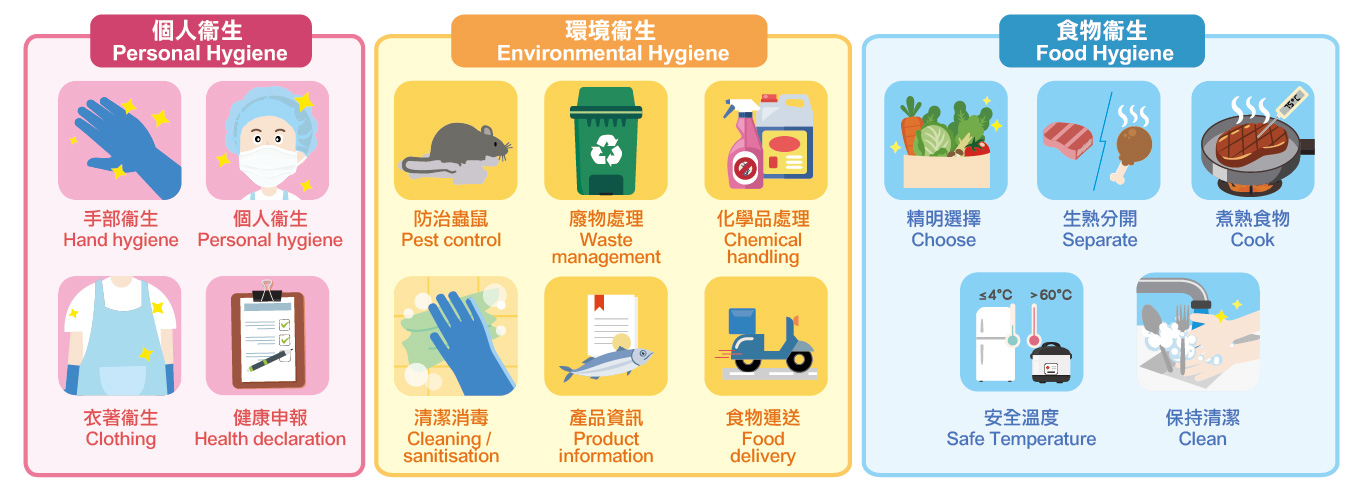
Food Safety Focus (207th Issue, October 2023) – Article 1
Soufflé Pancakes and Salmonella
Reported by Amy CHENG, Research Officer,
Risk Communication Section, Centre for Food Safety
In mid-August this year, the Centre for Food Safety (CFS) conducted an investigation of suspected food poisoning cases related to the consumption of soufflé pancakes from a local restaurant. The investigation revealed the causative pathogen was likely Salmonella. The investigation also found irregularities in the course of soufflé pancakes, namely improper storage temperature of pooled eggs, baking temperature of the soufflé pancakes not properly monitored and the use of unpasteurised whole shell eggs in preparation.
Potential Risk of Consuming Undercooked Egg Dishes
Salmonella can contaminate eggs during egg formation, facilitating proliferation if they are stored improperly. It can also survive in undercooked foods, which pose a very high risk of food safety as an inadequate heat treatment cannot eliminate pathogens completely and may cause food poisoning upon consumption. Besides Salmonella, undercooked egg dishes may also contain bacteria with antimicrobial resistance (AMR).
How to Store Egg Ingredients and Prepare Soufflé Pancake Safely?
Field investigation by the CFS found that the storage temperature of raw pooled eggs in the concerned restaurant was above 10°C, which was within the Temperature Danger Zone (i.e. between 4°C and 60°C). Storing food at the Temperature Danger Zone allows various types of bacteria to grow rapidly. Dried egg powder, once opened, should be stored in airtight containers placed in a cool and dry place. Refrigerators should include temperature displays, which are constantly monitored and reported at least twice a day. If any deviations higher than 1°C are identified, checking of the devices is warranted. In addition, applying first-in-first-out (FIFO) principle for egg ingredients is essential to keeping egg dishes safe. Unused egg products in the refrigerator should be stored in covered containers separately to avoid cross-contamination.
Lack of proper monitoring of the baking temperature of soufflé pancakes may explain the survival of harmful pathogens like Salmonella in this case. To prevent food poisoning, it is advisable to cook egg dishes thoroughly until the core temperature reaches 75°C or above, or the whole egg products are firm. Prolonged storage of cooked egg products at room temperature is also a common cause of food poisoning. Therefore, it is important to store hot dishes at above 60°C and cold dishes at 4°C or below, and plan ahead to avoid preparing them too far in advance.
Use Pasteurised Egg Products Wisely
Choosing safe egg ingredients is the priority step to ensure food safety. Pasteurised shell or liquid eggs are recommended as the pasteurisation process involves heating eggs to a specific temperature for a set time, aiming to prevent spoilage and extend their shelf-life. It can reduce the risk of foodborne illness especially when preparing egg dishes that are not intended to be cooked thoroughly for achieving the required texture. The occurrence of recent food poisoning cases related to egg products clearly illustrates the risk of using unpasteurised whole shell eggs for preparing these types of egg dishes. If pasteurised egg products are to be used later, store them in sealed containers in the refrigerator and only take out the amount required. Use all of them on the same day and do not top up with new batches of pasteurised egg products.
Be a Responsible Food Handler by Observing Good Hygiene Practices (GHPs)
GHPs refer to all practices regarding the conditions and measures necessary to ensure the safety and suitability of food at all stages of the food chain. Practising GHPs helps food business operators to control food safety hazards including biological (e.g. bacteria), chemical (e.g. pesticides) and physical (e.g. extraneous materials) hazards so as to make sure that the food they serve is safe to eat.
When soufflé pancakes are prepared, GHPs will include personal and environmental hygiene aspects, ranging from wearing suitable gloves and clean protective clothing to avoid contamination of the batter and the egg solution, the implementation of a regular pest control programme and to conduct kitchen cleansing operations for ensuring the production flow is free from pest and rodent infestations. In addition, GHPs emphasise the need for on-going training.

Figure 1: Personal, environmental and food hygiene aspects of Good Hygiene Practices (GHPs)
Key Points to Note:
- Undercooked egg dishes may contain pathogens like Salmonella and AMR strains that could lead to food poisoning and AMR transmission upon consumption respectively.
- Store egg ingredients properly and bake egg dishes thoroughly.
- Use pasteurised egg ingredients to prepare egg dishes that are not intended to be cooked thoroughly and observe GHPs.
Advice to the Trade
- Avoid preparing egg products too far in advance.
- Refrigerate egg ingredients at 4°C or below.
- Monitor the storage and cooking temperatures of eggs ingredients and dishes.
-
Observe GHPs.
Advice to the Public
- Purchase egg products from reliable shops and consume them immediately.
- Susceptible populations such as pregnant women, infants, young children, the elderly and people with weakened immunity should avoid consuming raw or undercooked dishes.

